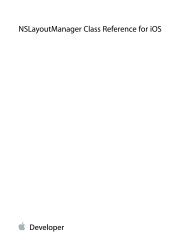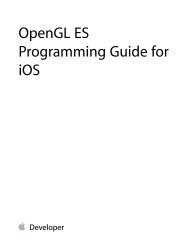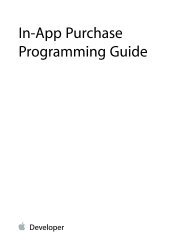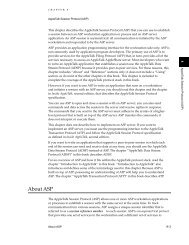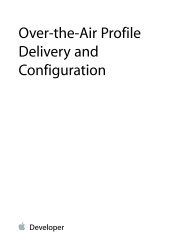URL Loading System Programming Guide - Apple Developer
URL Loading System Programming Guide - Apple Developer
URL Loading System Programming Guide - Apple Developer
You also want an ePaper? Increase the reach of your titles
YUMPU automatically turns print PDFs into web optimized ePapers that Google loves.
Life Cycle of a <strong>URL</strong> Session<br />
Life Cycle of a <strong>URL</strong> Session with Custom Delegates<br />
Life Cycle of a <strong>URL</strong> Session with Custom Delegates<br />
You can often use the NS<strong>URL</strong>Session API without providing a delegate. However, if you are using the<br />
NS<strong>URL</strong>Session API for background downloads and uploads, or if you need to handle authentication or caching<br />
in a nondefault manner, you must provide a delegate that conforms to the session delegate protocol, one or<br />
more task delegate protocols, or some combination of these protocols. This delegate serves many purposes:<br />
●<br />
When used with download tasks, the NS<strong>URL</strong>Session object uses the delegate to provide your app with<br />
a file <strong>URL</strong> where it can obtain the downloaded data.<br />
Delegates are required for all background downloads and uploads. These delegates must provide all of<br />
the delegate methods in the NS<strong>URL</strong>SessionDownloadDelegate protocol.<br />
●<br />
●<br />
●<br />
●<br />
●<br />
Delegates can handle certain authentication challenges.<br />
Delegates provide body streams for uploading stream-based data to the remote server.<br />
Delegates can decide whether to follow HTTP redirects or not.<br />
The NS<strong>URL</strong>Session object uses the delegate to provide your app with the status of each transfer. Data<br />
task delegates receive both an initial call, in which you can convert the request into a download, and<br />
subsequent calls, which provide pieces of data as they arrive from the remote server.<br />
Delegates are one way in which the NS<strong>URL</strong>Session object can tell your app when a transfer is complete.<br />
If you are using custom delegates with a <strong>URL</strong> session (required for background tasks), the complete life cycle<br />
of a <strong>URL</strong> session is more complex. Here is the basic sequence of method calls that your app must make and<br />
delegate calls that your app receives when using NS<strong>URL</strong>Session with a custom delegate:<br />
1. Create a session configuration. For background sessions, this configuration must contain a unique identifier.<br />
Store that identifier, and use it to reassociate with the session if your app crashes or is terminated or<br />
suspended.<br />
2. Create a session, specifying a configuration object and, optionally, a delegate.<br />
3. Create task objects within a session that each represent a resource request.<br />
Each task starts out in a suspended state. After your app calls resume on the task, it begins downloading<br />
the specified resource.<br />
The task objects are subclasses of NS<strong>URL</strong>SessionTask—NS<strong>URL</strong>SessionDataTask,<br />
NS<strong>URL</strong>SessionUploadTask, or NS<strong>URL</strong>SessionDownloadTask, depending on the behavior you are<br />
trying to achieve. These objects are analogous to NS<strong>URL</strong>Connection objects, but give you more control<br />
and a unified delegate model.<br />
Although your app can (and typically should) add more than one task to a session, for simplicity, the<br />
remaining steps describe the life cycle in terms of a single task.<br />
2013-10-22 | Copyright © 2003, 2013 <strong>Apple</strong> Inc. All Rights Reserved.<br />
66




